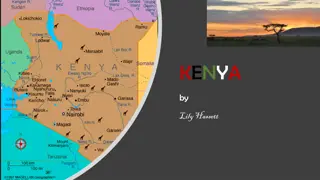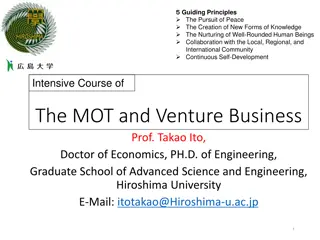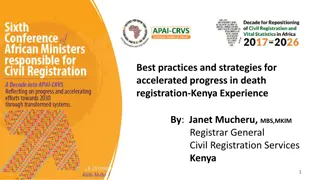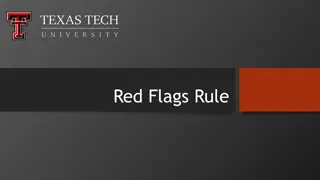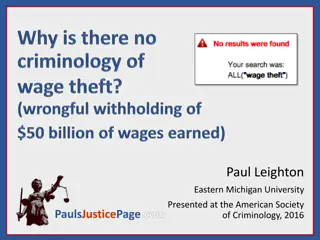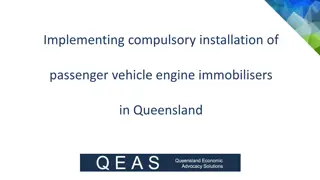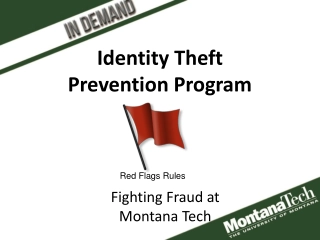Challenges and Impact of Stock Theft in Kenya: Lessons and Future Directions
Agricultural crime, particularly stock theft in Kenya, poses significant challenges affecting rural communities and the national economy. Livestock theft, a prevalent form of agricultural crime, not only results in financial losses but also undermines rural livelihoods and community cohesion. Despite the increasing frequency and intensity of stock theft incidents, efforts to prevent and mitigate such crimes remain insufficient.
Download Presentation

Please find below an Image/Link to download the presentation.
The content on the website is provided AS IS for your information and personal use only. It may not be sold, licensed, or shared on other websites without obtaining consent from the author. Download presentation by click this link. If you encounter any issues during the download, it is possible that the publisher has removed the file from their server.
E N D
Presentation Transcript
Stock theft in Kenya: Lesson, current challenges and future direction Mr. Emmanuel Bunei(MoiUniversity) CPA, CPS, BA, MA, PhD(C) ebunei2001@yahoo.com Keynote Address: INTERNATIONAL RURAL CRIME CONFERENCE The Challenges of rural crimes affecting Agriculture, 27 September 2017
Overview of agricultural crime Throughout the world; agricultural crime is one of the biggest concern affecting the rural communities (Barclay 2001; Barclay, Donnermeyer Doyle &Talary 2001; Anderson & McCall 2003 and Jones 2008; Bunei 2014; Bunei 2016; Bunei, McElwee & Smith 2016). Criminals are descending to rural farms to take advantage of rich pickings, hot products or gold: livestock, Grain, Crops (Green maize, Cassava , Bean, vanilla etc), fuel, machinery, Medicinal crops (Moringa in Zimbabwe) It has become a grim reaper of national economy, relationship, and community cohesiveness . Unfortunately, less has been done to avert or prevent agricultural crime.
Changing nature of Agricultural Crime in Africa In the past Currently Dramatic increased in agricultural crime Highly planned and organized Less or minimal agricultural crime More of spontaneous/opportunistic More of subsistence More of commercial/entrepreneurial More of one individual More of internal More of a criminal network Conflux of both internal and external Rural criminals , Urban criminals and travelling fraternities Smith in agricultural crime (2013). Entrepreneurial
Livestock theft Livestock are valuable assets, providing an important source of wealth, food and income, social identity, recognition, pride and status, symbol of prosperity and prestige and security against drought or other calamities (Bunei 2014; Kaprom 2013; KHRC 2010; Opiyo et al 2012). Cattle rustling vs single incidents livestock theft A single incidence of stock theft can mean a loss of not only the stock but also loss of time, hard work and trust. In recent decades, the frequency and intensity of the stock theft has reached uncontrollable level (Bunei et al 2016; Kaprom 2013; and Cheserek et al 2012)
Impact of stock theft It is a serious threat to rural livelihoods (Bunei & Barasa 2017; Bunei, 2014; Bunei, Rono & Chessa 2013; Kimaiyo 2016 Dzimba and Matoone 2005). It has pauperised and impoverished thousands in Africa (Kaprom 2013; KHRC 2010 and Osamba 2009).
Stock theft as organized crime It is an organized network that runs from bush (rural) to butchery (urban) . It is web of individuals involving locals, local administrators, police, livestock and meat traders, politicians, public health officials, and transporters It is a commercialised criminal venture: scouting (cattle and markets), planning, aiding and protecting criminals. Your life or stock (militarized and violent): rustlers are armed, police have been killed and farmers have lost life.
The rural-urban difference Rural areas Low security Unemployment Grinding poverty, Low literacy levels Globalization Urban areas Migration rapid population growth high urbanizing High business opportunity Globalization Huge demand for food Fortunately rural areas tend to offer cheap, fresh, sweet and perhaps organic meat Because of the high demand of meat but with low supply; criminal opportunity arises.
But why is it challenging to tame stock theft?
The four challenges? Corruption /lack of political will Lack of evidence Police incapacity/i nadequate response Sophisticate criminals
Conclusion and future direction 1. We need to take livestock identification seriously 2. Removal of bottle necks/constraints on criminal justice system. Provide modern technology and resources to police. Investigators, prosecutors and Magistrates handling stock theft issues should have profound knowledge of livestock, livestock theft and rural areas. Reduce costs of pursuing and prosecuting stock thieves; address corruption, Address language difficulties.
Conclusion and future direction 3. Investment in research and intelligence on stock theft. Causes of stock theft, Changing dynamics of stock theft, Perpetrators of stock theft, risk factors; OCGS for stock theft Financial and communication trails between OCGs 4. Strategic use of technology (social media, website) in combating stock theft.
Conclusion and future direction 5. Promote an integrate approach to stock theft a close and concerted partnership-based collaboration, interaction and information exchange between farmers , law enforcers, business communities, different government institutions and research institutions. Community policing Multi-agency approach we should think of Rural Crimes Unit.
End Emmanuel Bunei ebunei2001@yahoo.com +254724917456 Thank You
References Anderson, D. (1986), Stock theft and moral economy in Kenya , African Journal of International African Institute, Vol. 56 (4):399-415 Bunei, E. (2014) Factors influencing agricultural crimes in Kenya , unpublished thesis, Moi University, Eldoret, Kenya. Bunei, E., Rono, J. and Chessa, S. (2013) Factors influencing farm crimes in Kenya: opinions and experiences from Farmers , International Journal of Rural Criminology 2 (1): 75-100. Available online at: http (accessed on 11 October 2014). Clack, W. (2013) The extent of stock theft in South Africa , Acta Criminological. Vol 26(2): 77-91 Dzimba, J. and Matooane, M. (2005) Stock Theft and Human Security: A Case Study of Lesotho. Institute for Security Studies, Pretoria, South Africa Available at: (accessed on 20 October 2014). Faf Champs, M and Minten, B. Theft and rural poverty: Result of a natural experiment , paper presented at the 25th International Conference of Agricultural Economics (IAAE), Durban, South Africa, August 16-22, 2003. Kenya Human Rights Commission (KHRC), (2010) Morans No More: The Changing Face of Cattle-Rustling in Kenya , Kenya Human Rights Commission. Nairobi. Manu, I.N, Andu, W.N, Tarla, D.N. and Agharih, W.N. (2014) Causes of cattle theft in the North West Region of Cameroon , Scholarly Journal of Agricultural Science, Vol. 4(4): 181-187. Available online at http:// www.scholarly- journals.com/SJAS (accessed on 29 January 2015). Olowa, O. W. (2010) The effect of livestock pilferage on household poverty in developing countries: theoretical evidence from Nigeria ,Bangladesh e-journal, 7 (1): 42-46. Osamba, O. J. (2000) The Sociology of insecurity: Cattle-rustling and banditry in North-Western Kenya , African Journal on Conflict Resolution,Vol1 (2): 10-37. Available online: http://www.accord.org.za/publications/ajcr/downloads/94-publications/ajcr/343-ajcr-volume-01-no-2-2000 (accessed on 29 January, 2015).




